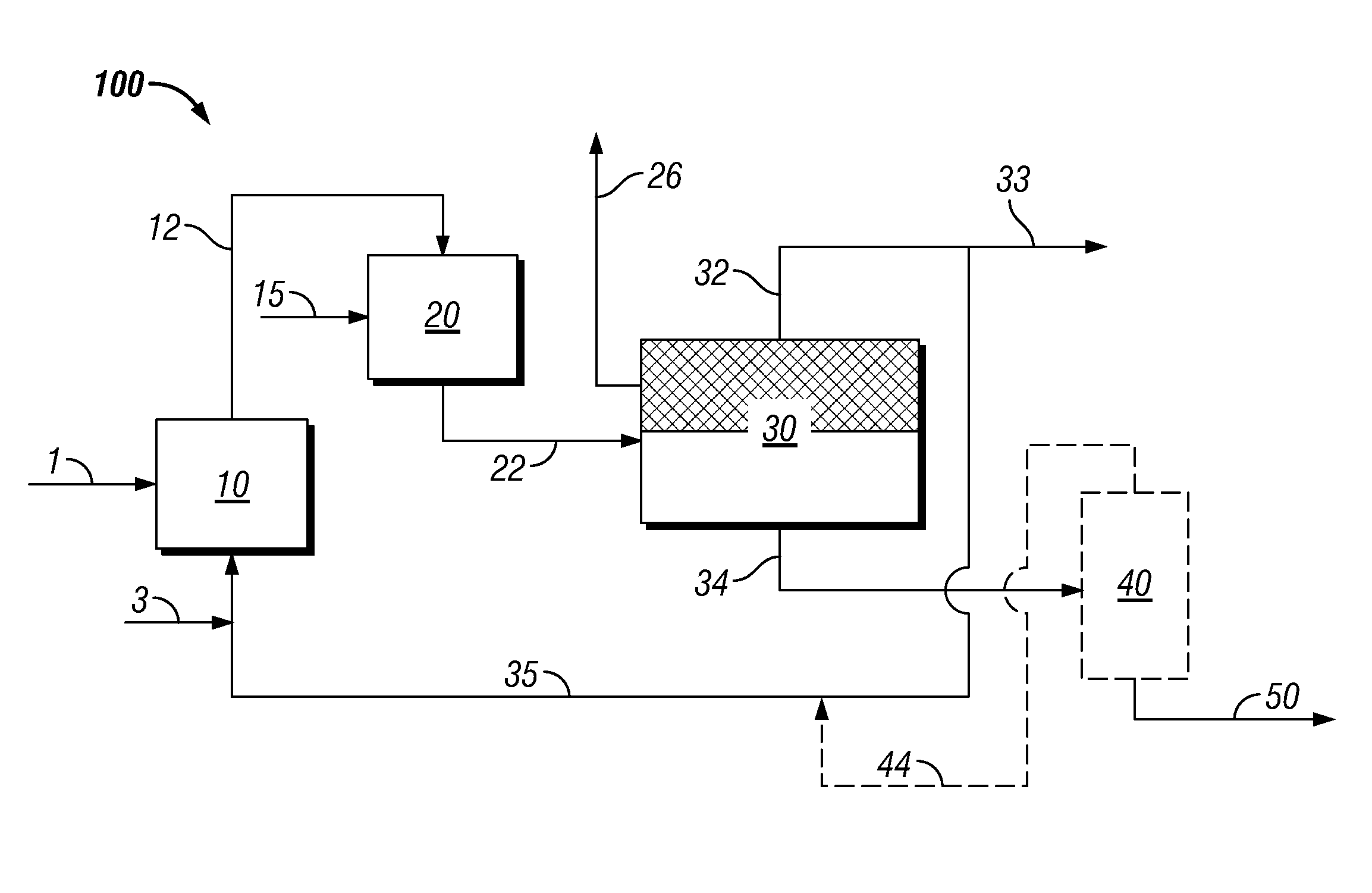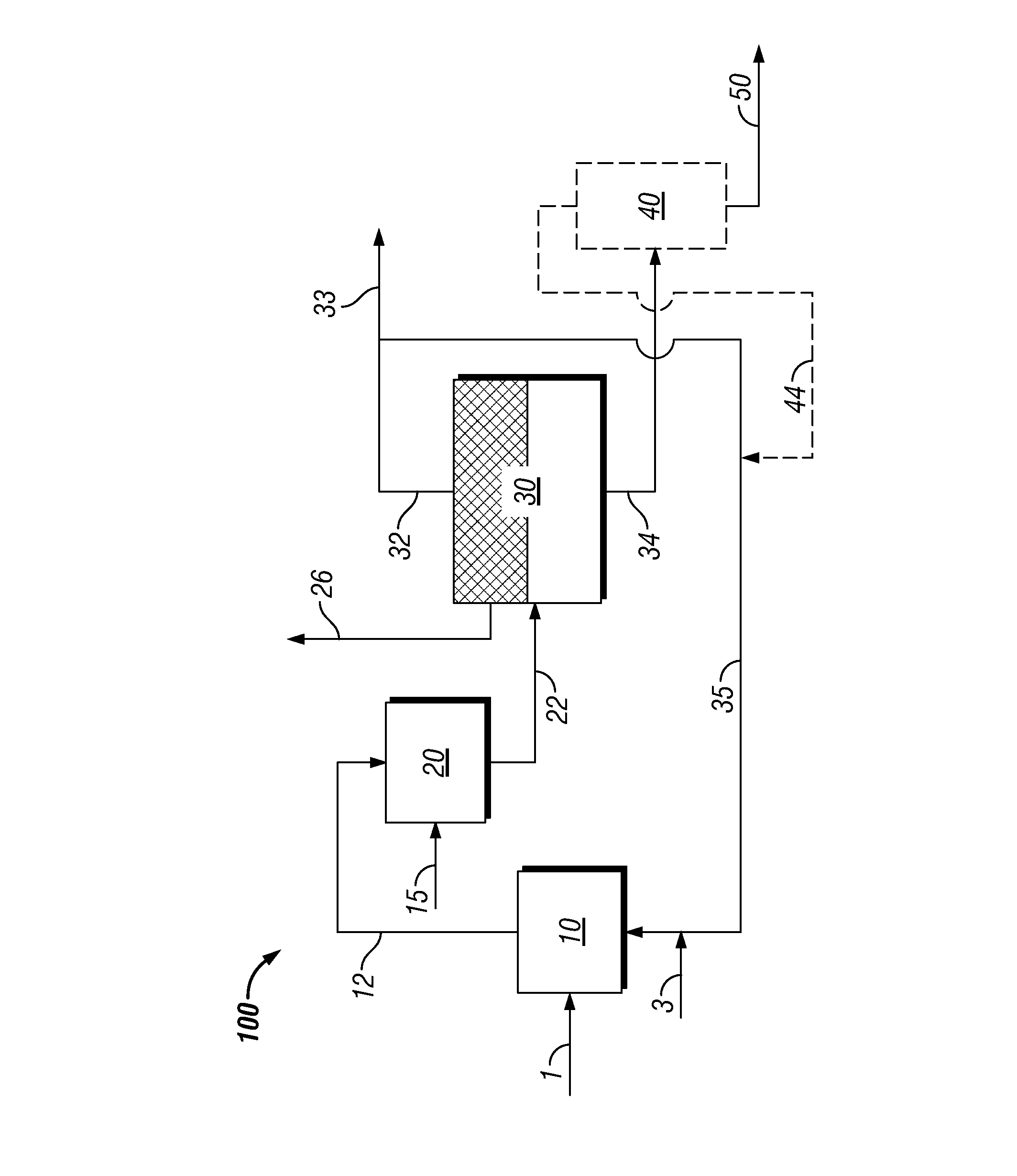Process to produce biofuels via organic phase thermal hydrocatalytic treatment of biomass
a biofuel and thermal hydrocatalytic technology, applied in biofuels, organic chemistry, fuels, etc., can solve the problems of difficult penetration of lignocellulose biomass with chemicals, difficult to break down the long chain polymer structure of cellulose into carbohydrates that can be used to produce fuel, and difficult to produce fuel from cellulos
- Summary
- Abstract
- Description
- Claims
- Application Information
AI Technical Summary
Benefits of technology
Problems solved by technology
Method used
Image
Examples
example 1
Aqueous Phase Hydrolysis and Reduction of Biomass
[0123]2.002 grams of ground soft pine wood (16% moisture; 67.8% carbohydrate on dry basis) were charged with 20.44 grams of deionized water, and 0.451 grams of 5% Ru / C Escat 4401 catalyst (from Strem Chemicals, Inc., 50% wet), to a Parr 5000 reactor. The reactor was pressured to 54 bar with H2, and ramped from 170-240° C. over 6 hours, before maintaining 240° C. overnight to complete reaction. Following reaction, solids were recovered by filtration on Whatman #2 filter paper, and oven dried overnight at 90° C. to assess the extent of digestion of biomoass. Results indicated greater than 90% digestion of the softwood charged, into liquid soluble products.
[0124]Gas chromatographic analysis of a sample of the resulting aqueous phase using the DB5-ox method indicated the presence of 1.41 wt % products relative to n-butanol internal standard. This corresponded to 41% of the theoretical yield, basis the carbohydrate content of the wood char...
example 2
Organic Phase Hydrolysis and Reduction of Biomass
[0125]2.007 grams of ground soft pine (16% moisture) were charged with 20.21 grams of a solvent comprising 8% deionized water and 92% 1-pentanol, and 0.455 grams of 5% Ru / C Escat 4401 catalyst (from Strem Chemicals, Inc., 50% wet), to a Parr 5000 reactor. This solvent composition was in the single phase region at 298 K, but near the phase boundry for maximum water solubility in 1-pentanol of 9. 8-10.2 wt %, as reported by M. Góral, B. Wiśniewska-Goclowska, and A. Mczyńskia in Recommended Liquid-Liquid Equilibrium Data, Part 4: 1-Alkanol—Water Systems, J. Phys. Chem. Ref. Data, Vol. 35, No. 3, 2006. Water solubility is increased at reaction temperature.
[0126]The reactor was pressured with hydrogen to 54 bar, and heated using the same schedule as Example 1. Filtration again revealed greater than 90% digestion of wood. Gas chromatographic analysis of the solvent phase via the DB5-ox method indicated 107% of the theoretical yield of hydro...
examples 3-6
[0128]The experiment of example 1 was repeated with 1-pentanol (examples 3 and 4), 1-octanol (example 5), and toluene (example 6) as solvent, and varying amounts of water relative to solubility limits in alcohol solvents reported by R. Stephenson, J. Stuart, M. Tabak, J. Chem. Eng. Data 1984, 29, 287-290, and in toluene as reported by B. J. Neely, J. Wagner, R. L. Robinson, Jr., K. A. M. Gasem, J. Chem. Eng. Data 2008, 53, 165-174. Reaction conditions and conversions are shown in Table 1. Examples #3, 4, and 6 used 5% Ru / C Escat 4401 catalyst (from Strem Chemicals, Inc., 50% wet) as catalyst. Example #5 used DC-2534 sulfided cobalt molybdate hydrotreating catalyst from Criterion Catalyst & Technologies L.P., and entailed addition of alanine and cysteine to the solvent mixture to model amino acids present in recycle solvent generated in a continuous process.
TABLE 1Parr5000 Wood Digestion and ReactionH2O wt %DryGC yieldH2OsolubilityAminowt %wood %(%ExSolventwt %20-25° C.acidCatalystca...
PUM
| Property | Measurement | Unit |
|---|---|---|
| temperature | aaaaa | aaaaa |
| temperature | aaaaa | aaaaa |
| pressure | aaaaa | aaaaa |
Abstract
Description
Claims
Application Information
 Login to View More
Login to View More - R&D
- Intellectual Property
- Life Sciences
- Materials
- Tech Scout
- Unparalleled Data Quality
- Higher Quality Content
- 60% Fewer Hallucinations
Browse by: Latest US Patents, China's latest patents, Technical Efficacy Thesaurus, Application Domain, Technology Topic, Popular Technical Reports.
© 2025 PatSnap. All rights reserved.Legal|Privacy policy|Modern Slavery Act Transparency Statement|Sitemap|About US| Contact US: help@patsnap.com



